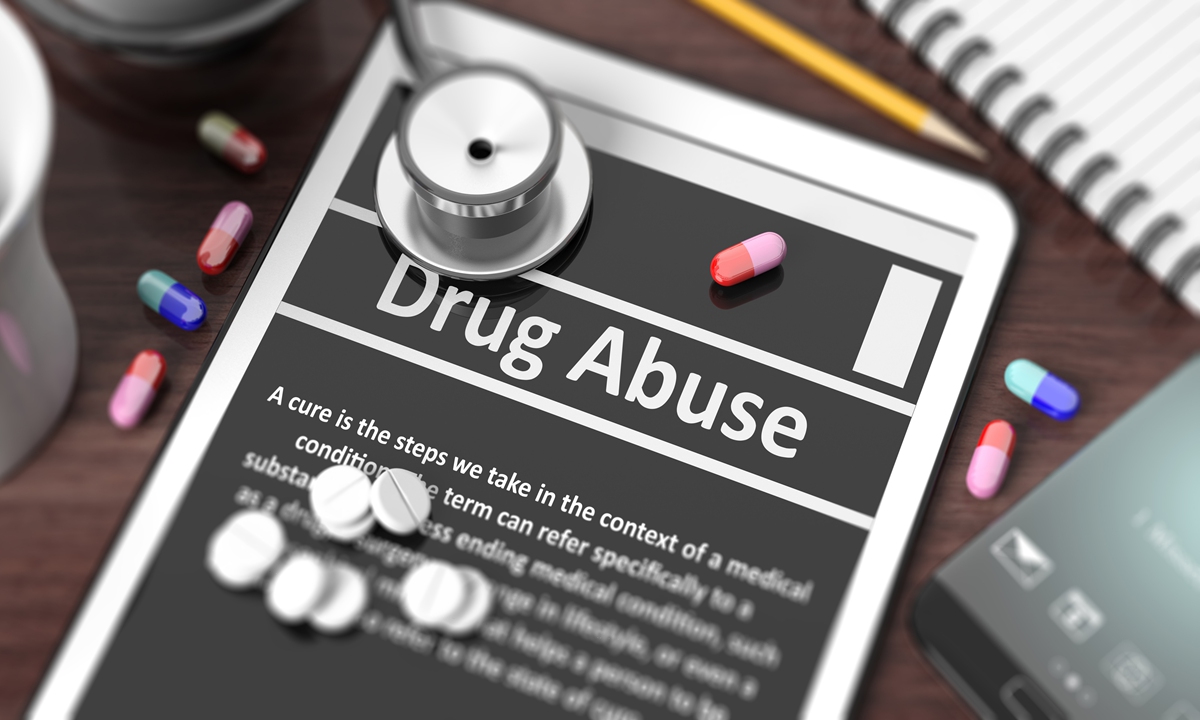
Drug abuse Photo: IC
A recent report released by the Chinese Foreign Ministry on Thursday showed the alarming situation of drug abuse in the US, with 12 percent of global drug users coming from the country, three times the US proportion of the global population, exposing the country's long-standing and deep-rooted problems.
The US should face its own problem squarely, take actions to deal with the issue, and protect the American people's right to life and health, instead of shying away from the problem, according to the report. The country is also urged to stop making unwarranted accusations against China and undermining China-US counter-narcotics cooperation, nor should it mislead the public and shift its responsibility for its ineffective response to drug abuse at home onto others, read the report.
The US National Center for Drug Abuse Statistics (NCDAS) lists eight categories of drugs most commonly used in the country: alcohol, cannabis, cocaine, fentanyl, opioids (mainly referring to controlled psychotropic substances), prescription stimulants, methamphetamine, and heroin.
According to the report, 46 percent of US drug users report having experienced using cannabis and prescription stimulants, 36 percent with opioids and methamphetamine, 31 percent with prescription stimulants, 15 percent with heroin and 10 percent with cocaine.
In 2021, findings by NCDAS showed that about 19.4 percent of Americans have used illegal substances at least once. Out of the 280 million people aged 12 and older, 31.9 million are drug users, with 11.7 percent on illegal substances and 19.4 percent either having consumed illicit drugs or misused prescription drugs in 2020. If alcohol and tobacco users are included, the number of people in the US who abuse substances totals 165 million, said the report.
During the past 12 months, 48.2 million Americans over the age of 18 consumed cannabis at least once. Though outlawed by the federal authorities, cannabis is legal in 15 states for recreational use. Legal cannabis sales in the US hit a record $17.5 billion in 2020, a 46 percent jump from that of 2019, according to BDSA, a platform providing cannabis sales data.
During the past 12 months, 10.1 million Americans have consumed opium at least once. According to the Centers for Disease Control and Prevention (CDC), opioid is the primary driver of the spike in drug-related deaths. Between April 2020 and April 2021, 75,000 Americans died from opium overuse, representing more than 75 percent of the total deaths from drug overdose and a 50 percent rise year on year.
Each year, 95,000 people in the country die from alcohol abuse. During the COVID-19 pandemic, over 60 percent of Americans increased their consumption of alcohol.
Also, adolescents are experiencing the fastest rise in drug overdose deaths. In this group, 18 to 25-year-olds are the heaviest drug users, with 39 percent of them using drugs. Seventy percent of drug users try illicit drugs before the age of 13, and drug users as a population group are becoming younger. The Journal of the American Medical Association (JAMA) reports that between January and June 2021, about 1,150 youngsters aged 14 to 18 died from drug overdose, a 20 percent increase from that of 2020 and more than double the number in 2019.
Drug abuse has led to enormous social cost in the country.
Drug overdose exacts a high death toll on the US population, greatly eroding the labor force base and weighing on life expectancy. According to a report in the American journal Science, the American death toll from drug overdose has increased exponentially over the past 38 years - up 9 percent almost every year and doubling about every eight years. A record 72,000 deaths were registered in 2017.
The damage to cranial nerves caused by drug taking may aggravate anxiety and cognitive disorder, induce some mental illnesses, and cause emotion dysregulation, thus leading to problems like family discord, violent crimes, and psychological trauma in children.
Also, drug control measures incur tremendous social costs. Since 1971, the US has spent 1 trillion dollars combating drug-related crimes, according to a study by the University of Pennsylvania. In 2017, the cost of drug control in the US exceeded $270 billion.
The report pointed out that the US government has pushed for the legalization of cannabis and other drugs out of economic considerations. Legalizing cannabis allows the government to generate significant tax revenues from the legal drug market, and in turn, the distribution of such revenues becomes an important driver of drug legalization.
The drug problem is a manifestation of the US' failure in social governance. According to Howard Koh, former assistant secretary for health for the US Department of Health and Human Services, drug and substance abuse in the country is one of its most devastating public health disasters. In addition to putting a heavy burden on the public health system, it could lead to millions of people losing their homes or jobs, truancy or family breakdown. The COVID-19 pandemic masked this crisis, but at the same time also amplified it. The crisis shows the US government's failed regulation across multiple systems, and it is imperative to make a prompt, unified and comprehensive response, he said.
Global Times

